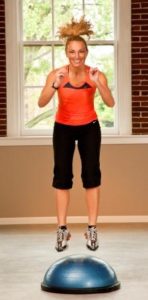Kegel Your Way to Better Health

An inability to control urine flow when you age can be a socially embarrassing problem that can be managed. Stress incontinence or the loss of urine when you cough, sneeze, laugh, or jump is a result of the weakening of your pelvic floor muscles – part of your core.
A plan of action that you can start immediately is performing regular Kegel exercises which strengthen these muscles. The pelvic floor muscles control the vagina, urethra and anus. They provide support for the uterus and other pelvic organs and keep the bladder from leaking when you can’t make it to the bathroom quickly or when you are exercising, coughing, laughing, or lifting. A Kegel exercise is the same action you would perform if you were trying to stop your urine stream. A word of caution, however, is that you should not perform this exercise while urinating as it will disrupt your voiding patterns and may cause infection.
There are two protocols for Kegel exercises, one which will help to avoid urine leakage and the other which will give you the endurance you need to make it to the bathroom when you do have to go. You can perform these exercises anywhere, anytime. Perhaps you can incorporate them while in the shower, brushing your teeth, while driving or before you fall asleep in bed.

Kegel Exercise #1
Firmly, as hard as you can, tense your pelvic floor muscles by inwardly lifting and squeezing them. Focus on the weaker areas around the vagina (frontal) versus the anus (posterior). Hold this contraction for 2 seconds with a 4 second rest in between. Do one set of 10 reps, three times per week. Gradually build to 3 sets of 10 reps.
Kegel Exercise #2
Firmly, tense your pelvic floor muscles by inwardly lifting and squeezing them. Again, focus on the weaker areas around the vagina (frontal) versus the anus (posterior). Hold this contraction for 10 seconds and as each second passes, try to contract a little more forcefully. Rest for 20 seconds. Do 10 sets, four to five times per week. Gradually build to 10 sets of a 20 second contraction and a 40 second rest.
Another important point to make is that many occupational therapists are encouraging women to Kegel during any strength exercise for two reasons. First, it’s an important exercise to do and secondly, while Kegeling, it’s been discovered that you can generate more power in other muscles including your buttocks and abdominals. So, let’s say you’re about to do a squat. Start by lining up your feet, knees and hips, check to make sure your abdominals are contracted, shoulder blades are pulled down and back, and your chest is up and out. Then initiate a Kegel contraction and begin the squat.
Kegel exercises may also help with sexual performance.
Kegels are beneficial to both men and women, but since women are at a higher risk for stress incontinence, these exercisers are a must for women.
In the event these exercises do not provide any relief, consult with your physician. You may require a more aggressive protocol to resolve the issue.
Yours in health & fitness,
Sherri McMillan
